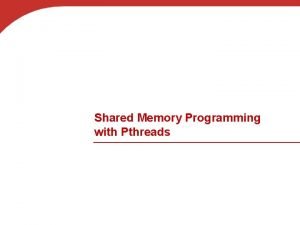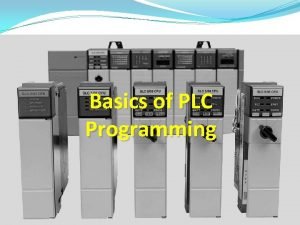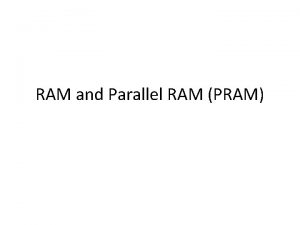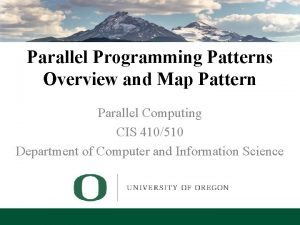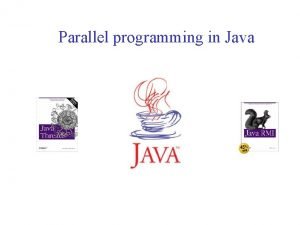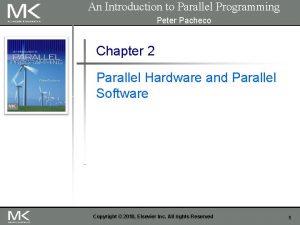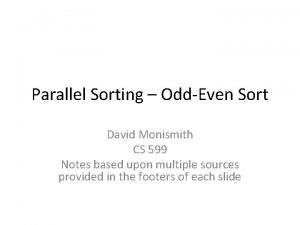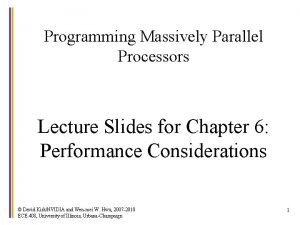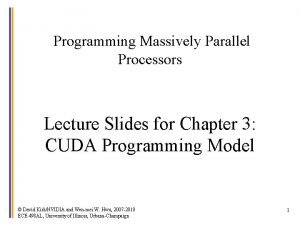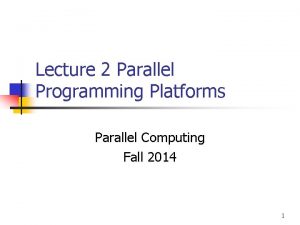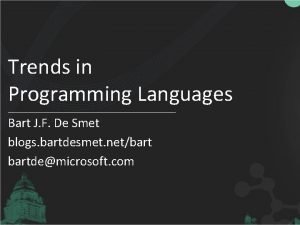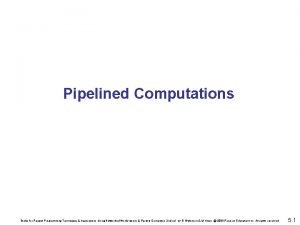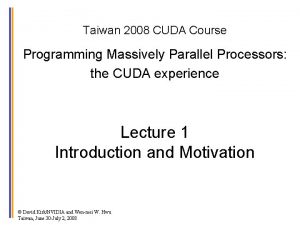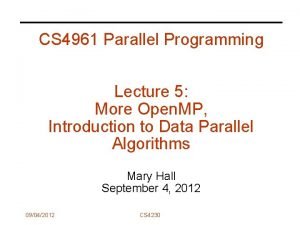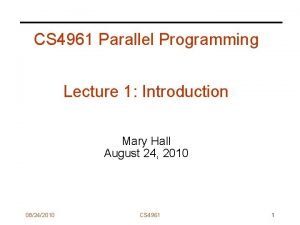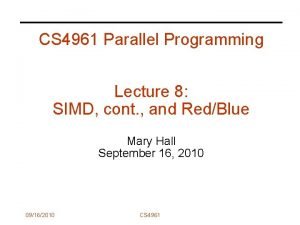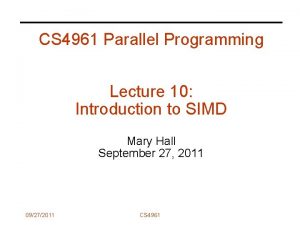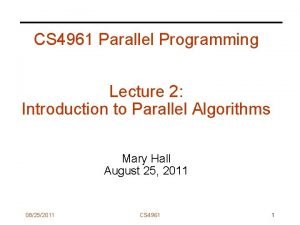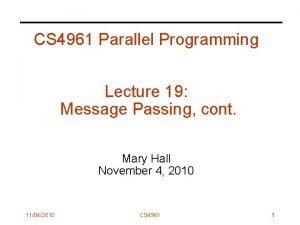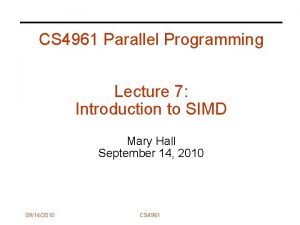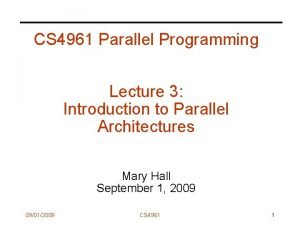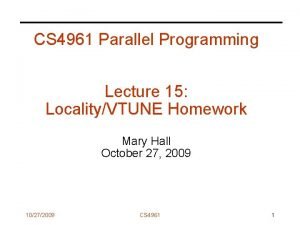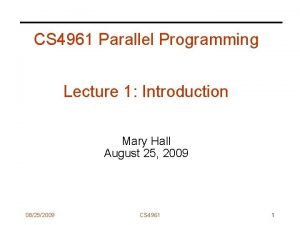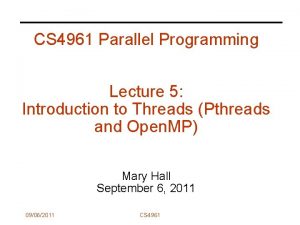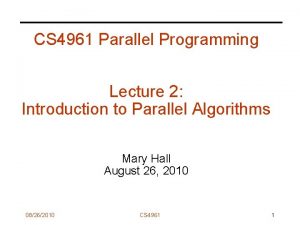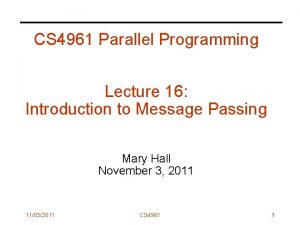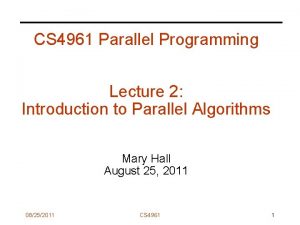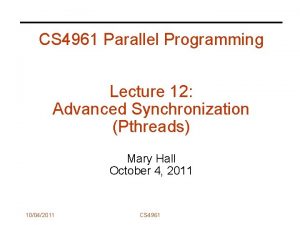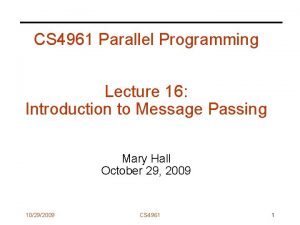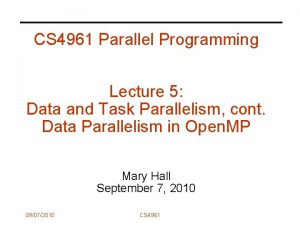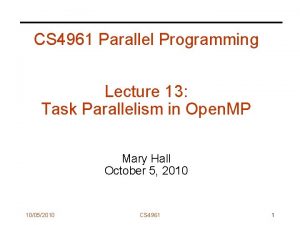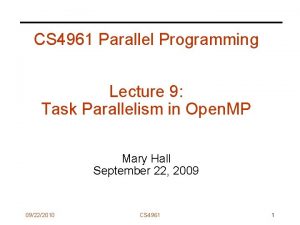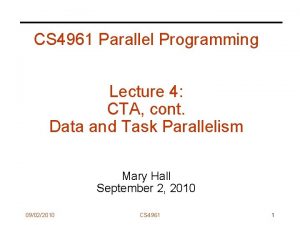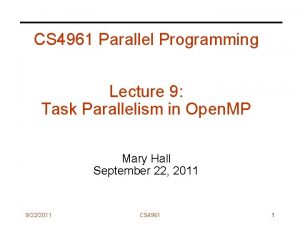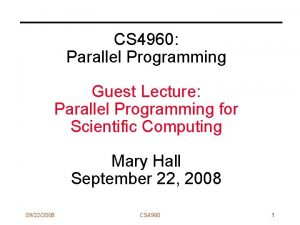CS 4961 Parallel Programming Lecture 4 Memory Systems








































- Slides: 40

CS 4961 Parallel Programming Lecture 4: Memory Systems and Interconnects Mary Hall September 1, 2011 09/01/2011 CS 4961 1

Administrative • Nikhil office hours: - Monday, 2 -3 PM - Lab hours on Tuesday afternoons during programming assignments • First homework will be treated as extra credit - If you turned it in late, or up until tomorrow, turn in for half credit 09/01/2011 CS 4961 2

Homework 2: Due Before Class, Thursday, Sept. 8 ‘handin cs 4961 hw 2 <file>’ Problem 1: (Coherence) #2. 15 in textbook (a) Suppose a shared-memory system uses snooping cache coherence and write-back caches. Also suppose that core 0 has the variable x in its cache, and it executes the assignment x=5. Finally, suppose that core 1 doesn’t have x in its cache, and after core 0’s update to x, core 1 tries to execute y=x. What value will be assigned to y? Why? (b) Suppose that the shared-memory system in the previous part uses a directory-based protocol. What value will be assigned to y? Why? (c) Can you suggest how any problems you found in the first two parts might be solved? 09/01/2011 CS 4961 3

Homework 2, cont. Problem 2: (Bisection width/bandwidth) (a) What is the bisection width and bisection bandwidth of a 3 -d toroidal mesh. (b) A planar mesh is just like a toroidal mesh, except that it doesn’t have the wraparound links. What is the bisection width and bisection bandwidth of a square planar mesh. Problem 3 (in general, not specific to any algorithm): How is algorithm selection impacted by the value of λ? 09/01/2011 CS 4961 4

Homework 2, cont. Problem 4: (λ concept) #2. 10 in textbook Suppose a program must execute 1012 instructions in order to solve a particular problem. Suppose further that a single processor system can solve the problem in 106 seconds (about 11. 6 days). So, on average, the single processor system executes 10 6 or a million instructions per second. Now suppose that the program has been parallelized for execution on a distributed-memory system. Suppose also that if the parallel program uses p processors, each processor will execute 1012/p instructions, and each processor must send 109 (p-1) messages. Finally, suppose that there is no additional overhead in executing the parallel program. That is, the program will complete after each processor has executed all of its instructions and sent all its messages, and there won’t be any delays due to things such as waiting for messages. (a) Suppose it takes 10 -9 seconds to send a message. How long will it take the program to run with 1000 processors, if each processor is as fast as the single processor on which the serial program was run? (b) Suppose it takes 10 -3 seconds to send a message. How long will it take the program to run with 1000 processors? 09/01/2011 CS 4961 5

Today’s Lecture • Key architectural features affecting parallel performance - Memory systems - Memory access time - Cache coherence - Interconnect • A few more parallel architectures - Sunfire SMP - BG/L supercomputer • An abstract architecture for parallel algorithms • Sources for this lecture: - Textbook - Larry Snyder, “http: //www. cs. washington. edu/education/courses/524/08 w 09/01/2011 i/” CS 4961 6

An Abstract Parallel Architecture • How is parallelism managed? • Where is the memory physically located? • Is it connected directly to processors? • What is the connectivity of the network? 09/01/2011 CS 4961 7

Memory Systems • There are three features of memory systems that affect parallel performance - Latency: Time between initiating a memory request and it being serviced by the memory (in micro-seconds). - Bandwidth: The rate at which the memory system can service memory requests (in GB/s). - Coherence: Since all processors can view all memory locations, coherence is the property that all processors see the memory image in the same state. 09/01/2011 CS 4961 8

Uniform Memory Access (UMA) multicore system Time to access all the memory locations will be the same for all the cores. Figure 2. 5 Copyright © 2010, Elsevier Inc. All rights Reserved

Non-uniform Memory Access (NUMA) multicore system A memory location a core is directly connected to can be accessed faster than a memory location that must be accessed through another chip. Copyright © 2010, Elsevier Inc. All rights Reserved Figure 2. 6

Cache coherence • Programmers have no control over caches and when they get updated. Figure 2. 17 A shared memory system with two cores and two caches Copyright © 2010, Elsevier Inc. All rights Reserved

Cache coherence y 0 privately owned by Core 0 y 1 and z 1 privately owned by Core 1 x = 2; /* shared variable */ y 0 eventually ends up = 2 y 1 eventually ends up = 6 z 1 = ? ? ? Copyright © 2010, Elsevier Inc. All rights Reserved

Snooping Cache Coherence • The cores share a bus. • Any signal transmitted on the bus can be “seen” by all cores connected to the bus. • When core 0 updates the copy of x stored in its cache it also broadcasts this information across the bus. • If core 1 is “snooping” the bus, it will see that x has been updated and it can mark its copy of x as invalid. Copyright © 2010, Elsevier Inc. All rights Reserved

Directory Based Cache Coherence • Uses a data structure called a directory that stores the status of each cache line. • When a variable is updated, the directory is consulted, and the cache controllers of the cores that have that variable’s cache line in their caches are invalidated. Copyright © 2010, Elsevier Inc. All rights Reserved

Definitions for homework Problem #1 • Write through cache - A cache line is written to main memory when it is written to the cache. • Write back cache - The data is marked as dirty in the cache, and written back to memory when it is replaced by a new cache line. 09/01/2011 CS 4961 15

False Sharing • A cache line contains more than one machine word. • When multiple processors access the same cache line, it may look like a potential race condition, even if they access different elements. • Can cause coherence traffic. 09/01/2011 CS 4961 16

Shared memory interconnects • Bus interconnect - A collection of parallel communication wires together with some hardware that controls access to the bus. - Communication wires are shared by the devices that are connected to it. - As the number of devices connected to the bus increases, contention for use of the bus increases, and performance decreases. Copyright © 2010, Elsevier Inc. All rights Reserved

Shared memory interconnects • Switched interconnect - Uses switches to control the routing of data among the connected devices. - Crossbar – - Allows simultaneous communication among different devices. Faster than buses. But the cost of the switches and links is relatively high. Crossbars grow as n 2 making them impractical for large n Copyright © 2010, Elsevier Inc. All rights Reserved

Figure 2. 7 (a) A crossbar switch connecting 4 processors (Pi) and 4 memory modules (Mj) (b) Configuration of internal switches in a crossbar (c) Simultaneous memory accesses by the processors Copyright © 2010, Elsevier Inc. All rights Reserved

Sun. Fire E 25 K • 4 Ultra. Sparcs • Dotted lines represent snooping • 18 boards connected with crossbars - Basically the limit - Increasing processors per node will, on average, increase congestion Copyright © 2009 Pearson Education, Inc. Publishing as Pearson Addison-Wesley 09/01/2011 CS 4961 20

Distributed memory interconnects • Two groups - Direct interconnect - Each switch is directly connected to a processor memory pair, and the switches are connected to each other. - Indirect interconnect - Switches may not be directly connected to a processor. • The cost of an interconnect can be a big part of a machine, governed by - Number of links - Number of switches - Available bandwidth (highly optimized links are expensive) Copyright © 2010, Elsevier Inc. All rights Reserved

Direct interconnect Figure 2. 8 ring Copyright © 2010, Elsevier Inc. All rights Reserved toroidal mesh

Like memory systems, we also consider bandwidth and latency in message-passing Message transmission time = l + n / b latency (seconds) length of message (bytes) bandwidth (bytes per second) Copyright © 2010, Elsevier Inc. All rights Reserved

Definitions • Bisection width - A measure of “number of simultaneous communications” or “connectivity”. - How many simultaneous communications can take place “across the divide” between the halves? • Bisection bandwidth - A measure of network quality. - Instead of counting the number of links joining the halves, it sums the bandwidth of the links. Copyright © 2010, Elsevier Inc. All rights Reserved

Two bisections of a ring Figure 2. 9 Copyright © 2010, Elsevier Inc. All rights Reserved

A bisection of a toroidal mesh Figure 2. 10 Copyright © 2010, Elsevier Inc. All rights Reserved

Fully connected network im pr ac tic a l • Each switch is directly connected to every other switch. bisection width = p 2/4 Figure 2. 11 Copyright © 2010, Elsevier Inc. All rights Reserved

Indirect interconnects • Simple examples of indirect networks: - Crossbar - Omega network • Often shown with unidirectional links and a collection of processors, each of which has an outgoing and an incoming link, and a switching network. Copyright © 2010, Elsevier Inc. All rights Reserved

A generic indirect network Figure 2. 13 Copyright © 2010, Elsevier Inc. All rights Reserved

Supercomputer: BG/L Node • Actually has multiple interconnects Copyright © 2009 Pearson Education, Inc. Publishing as Pearson Addison-Wesley 09/01/2011 CS 4961 30

BG/L Interconnect • Separate networks for control and data • 3 -d torus� • Can then specialize network implementation for type of message • Also reduces congestion 09/01/2011 collective network CS 4961 31

Blue Gene/L Specs • BG/L was the fastest computer in the world (#1 on the Top 500 List) when the textbook was published • A 64 x 32 torus = 65 K 2 -core processors • Cut-through routing gives a worst-case latency of 6. 4 µs • Processor nodes are dual PPC-440 with “double hummer” FPUs • Collective network performs global reduce for the “usual” functions 09/01/2011 CS 4961 32

Summary of Architectures Two main classes • Complete connection: CMPs, SMPs, X-bar - Preserve single memory image - Complete connection limits scaling to … - Available to everyone (multi-core) • Sparse connection: Clusters, Supercomputers, Networked computers used for parallelism (Grid) - Separate memory images - Can grow “arbitrarily” large - Available to everyone with LOTS of air conditioning • Programming differences are significant 09/01/2011 CS 4961 33

Parallel Architecture Model • How to develop portable parallel algorithms for current and future parallel architectures, a moving target? • Strategy: - Adopt an abstract parallel machine model for use in thinking about algorithms 1. Review how we compare algorithms on sequential architectures 2. Introduce the CTA model (Candidate Type Architecture) 3. Discuss how it relates to today’s set of machines 09/01/2011 CS 4961 34

How did we do it for sequential architectures? • Sequential Model: Random Access Machine - Control, ALU, (Unlimited) Memory, [Input, Output] - Fetch/execute cycle runs 1 inst. pointed at by PC - Memory references are “unit time” independent of location - Gives RAM it’s name in preference to von Neumann - “Unit time” is not literally true, but caches provide that illusion when effective - Executes “ 3 -address” instructions • Focus in developing sequential algorithms, at least in courses, is on reducing amount of computation (useful even if imprecise) - Treat memory time as negligible - Ignore overheads 09/01/2011 CS 4961 35

Interesting Historical Parallel Architecture Model, PRAM • Parallel Random Access Machine (PRAM) - Unlimited number of processors - Processors are standard RAM machines, executing synchronously - Memory reference is “unit time” - Outcome of collisions at memory specified - EREW, CRCW … • Model fails to capture true performance behavior - Synchronous execution w/ unit cost memory reference does not scale - Therefore, parallel hardware typically implements non-uniform cost memory reference 09/01/2011 CS 4961 36

Candidate Type Architecture (CTA Model) • A model with P standard processors, d degree, λ latency • Node == processor + memory + NIC • Key Property: Local memory ref is 1, global memory is λ Copyright © 2009 Pearson Education, Inc. Publishing as Pearson Addison-Wesley 09/01/2011 CS 4961 37

Estimated Values for Lambda • Captures inherent property that data locality is important. • But different values of Lambda can lead to different algorithm strategies Copyright © 2009 Pearson Education, Inc. Publishing as Pearson Addison-Wesley 09/01/2011 CS 4961 38

Key Lesson from CTA • Locality Rule: - Fast programs tend to maximize the number of local memory references and minimize the number of non-local memory references. • This is the most important thing you will learn in this class! 09/01/2011 CS 4961 39

Summary of Lecture • Memory Systems - UMA vs. NUMA - Cache coherence • Interconnects - Bisection bandwidth • Models for parallel architectures - CTA model 09/01/2011 CS 4961 40
 01:640:244 lecture notes - lecture 15: plat, idah, farad
01:640:244 lecture notes - lecture 15: plat, idah, farad Shape memory alloys lecture notes
Shape memory alloys lecture notes C programming lecture
C programming lecture Parallel and distributed computing lecture notes
Parallel and distributed computing lecture notes Episodic vs semantic memory
Episodic vs semantic memory Implicit explicit memory
Implicit explicit memory Long term memory vs short term memory
Long term memory vs short term memory Internal memory and external memory
Internal memory and external memory Primary memory and secondary memory
Primary memory and secondary memory Logical memory is broken into
Logical memory is broken into Which memory is the actual working memory?
Which memory is the actual working memory? Virtual memory
Virtual memory Virtual memory in memory hierarchy consists of
Virtual memory in memory hierarchy consists of Eidetic memory vs iconic memory
Eidetic memory vs iconic memory Symmetric shared memory architecture
Symmetric shared memory architecture Google translate
Google translate Explain plc memory organization
Explain plc memory organization Perbedaan linear programming dan integer programming
Perbedaan linear programming dan integer programming Greedy programming vs dynamic programming
Greedy programming vs dynamic programming What is system programming
What is system programming Integer programming vs linear programming
Integer programming vs linear programming Perbedaan linear programming dan integer programming
Perbedaan linear programming dan integer programming Advanced operating system notes
Advanced operating system notes Lecture sound systems
Lecture sound systems Lecture sound systems
Lecture sound systems Parallel ram
Parallel ram Programming massively parallel processors
Programming massively parallel processors Scala parallel map
Scala parallel map What is parallel programming in java
What is parallel programming in java An introduction to parallel programming peter pacheco
An introduction to parallel programming peter pacheco Bubble sort parallel programming
Bubble sort parallel programming Mpi parallel programming in c
Mpi parallel programming in c Programming massively parallel processors
Programming massively parallel processors Massively parallel processing ppt
Massively parallel processing ppt Parallel programming platforms
Parallel programming platforms F# parallel programming
F# parallel programming Parallel programming
Parallel programming Programming massively parallel processors, kirk et al.
Programming massively parallel processors, kirk et al. Unlike parallel forces definition
Unlike parallel forces definition Look for the two innermost diverging ridges
Look for the two innermost diverging ridges Annie's dress was old, faded, and it had wrinkles.
Annie's dress was old, faded, and it had wrinkles.















